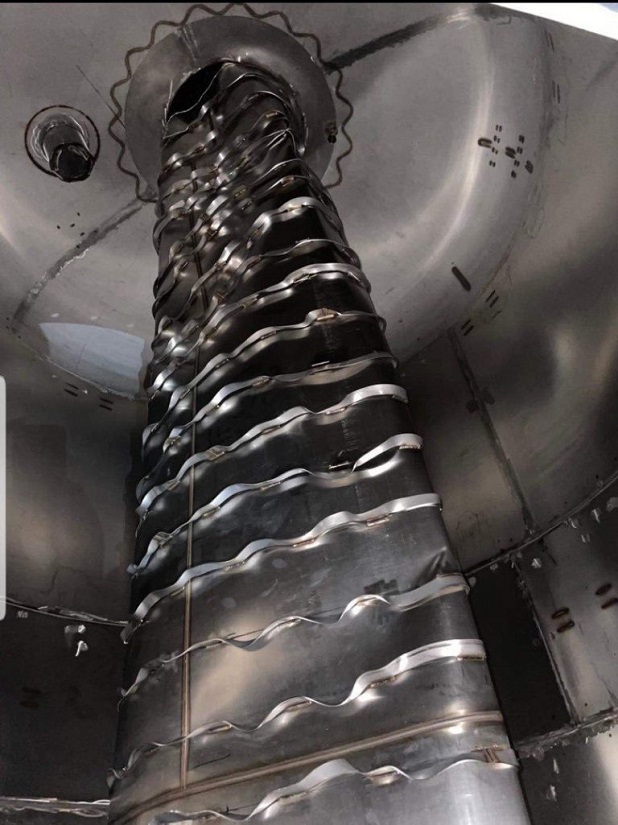As I write, starting around 7:30 PM ET, cryogenic testing is completing on Booster 7 at Starbase Boca Chica, Texas, after repair and return to the test area last week.
Naturally, we don't get updates on how the tests went unless either SpaceX's corporate account announces it (very rare) or Elon Musk does (much more common). Just as before, when the first issues showed up with Booster 7 (B7), we were scraping for information on what happened to the booster. Eric Ralph at Teslarati has compiled what he was able to find out in a post today.
The stand SpaceX modified specifically for Super Heavy B7 was outfitted with 13 hydraulic rams to simulate the full thrust of the booster’s central Raptor V2 engines – up to almost 3000 tons (~6.6M lbf) compared to Booster 4’s ~1700 tons (~3.7M lbf) with a smaller cluster of nine engines.
After a few false starts and minor tests on the stand, Booster 7 finally managed some significant testing on April 14th. Judging by the rhythmic shattering of ice that built up on Super Heavy’s tanks, the test stand was able to simulate the thrust of Raptors to some degree and subject the booster to major mechanical stress that was felt from tip to tail. Within a few days, Booster 7 was removed from the test stand and returned to the high bay on April 18th. Around April 21st or 22nd, an image was leaked showing extensive damage inside Booster 7, confirming that the Super Heavy’s test campaign had been forced to end prematurely.
My problem with this image of the extensive damage is that I don't have an equivalent "before" picture to compare it to. All I know is that other tubes called "downcomers" are cylindrical with flat reinforcing (?) rings on then. This one could have been different but probably wasn't. Looking at the top of the picture where
the deformed tube with strange shapes welded to it reaches a
flange, it looks like the tube was originally round and collapsed into
this shape ripping out of that flange at about 10 to 12 o'clock on the flange (a gaping, black opening).
Right away, the damage shown in the photo hinted at an operational failure, meaning that mistakes made by the rocket’s operators may have been more to blame than a possible design flaw. The photo shows a short portion of B7’s liquid methane (LCH4) transfer tube that runs through the booster’s new liquid oxygen (LOx) header tank, which itself sits inside Super Heavy’s main LOx tank at the aft end of the rocket – a tube inside a small tank inside a large tank, in other words. Super Heavy’s LCH4 transfer tube generally does what it says, allowing methane to safely fly down through the main LOx tank and fuel up to 33 Raptor engines. At full thrust, that tube would need to supply around 20 tons (~45,000 lb) of methane per second.
However, on top of merely transferring methane through the oxygen tank, Booster 7 introduced a design change that allows some or all of that tube to change functions and become a header tank mid-flight. That would require a system of valves that could seal off the main LCH4 tank once it was emptied, turning the transfer tube into a sort of giant steel straw filled with enough LCH4 to fuel Super Heavy’s boost-back and landing burns.
Amateur analysts naturally combed over the image and whatever they could find, including one guy who posted an impressive 18 minute video which convincingly pinpointed the moment Booster 7’s transfer tube collapsed.
(He goes over other topics, too, but the failure analysis is roughly between the six and 14 minute marks.) Simultaneously, because it showed that the transfer tube likely imploded
during detanking, the analysis more or less confirmed the view that the failure had been caused by either an operator
error or poor test design - or both.
Shades of Starship prototype SN3 in April of '20.
Could have been hardware, software, or operator error, but the important part is that when B7 reached the high bay and this photo was leaked, SpaceX decided it was reasonable to fix the damage. After having been in repair since April 18th, B7 rolled back out to the test area on Friday, May 6th. Today's cryogenic testing is completed, and the backup day for a road closure tomorrow has been cancelled. More often than the other way, "alternate" road closures cancelled after the first day of a test has been because the test passed, not that it failed.


Interesting that they chose to fix rather than junk the booster. Good on them.
ReplyDeleteI would've scrapped the booster, as there was no way to get another downcomer tube through the tank access hatch, but they got sheets of 304 stainless through the hatch and must have welded it together enough to test.
ReplyDeleteIt won't launch, however. B8 is now the favorite along with S24 or maybe even S25.
It's in the category of things I'd really have to think long and hard about doing, and I'd want tons of safety measures in place. Like working in my attic unless it's under 50 outside.
DeleteBut they must have repaired it from inside. I don't see any other way they could get a tube like that into the booster.
How much you want to bet they've developed air conditioned suits for the guys doing that?